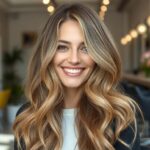Korean men’s hairstyles have taken the industry by storm and we can’t get enough of their effortlessly cool aesthetic. From the classic two-block cuts to modern textured styles these haircuts blend sophistication with contemporary edge that’s perfect for any occasion.
We’ve watched K-pop stars and Korean actors showcase these versatile looks that work beautifully with different face shapes and hair textures. The beauty of Korean haircuts lies in their attention to detail and the way they frame facial features while maintaining that coveted natural movement.
Whether you’re looking for a subtle refresh or a complete style transformation Korean-inspired cuts offer endless possibilities. We’ll explore the most popular Korean haircuts for men and show you exactly how to achieve these trending looks that’ll have everyone asking about your barber.
Two Block Cut: The Most Popular Korean Men’s Hairstyle
The two block cut dominates Korean men’s hairstyling with its clean, structured appearance that perfectly embodies the sophisticated aesthetic we’ve explored. This versatile haircut creates a striking contrast between longer top sections and shorter sides.
What Makes the Two Block Cut Distinctive
Distinct layering creates the signature look through contrasting hair lengths on different sections of the head. The top portion maintains 3-4 inches of length while sides and back are trimmed to 1-2 inches or shorter.
Sharp transitions between the blocks eliminate gradual fading, creating clean lines that define each section. Professional barbers achieve this by using different clipper guards and scissors to maintain precise boundaries.
Versatile top styling allows for multiple looks including swept back, textured forward, or side parted arrangements. The longer upper section provides flexibility for formal occasions and casual settings.
Minimal maintenance requirements make this cut practical for busy lifestyles. Weekly touch ups keep the sides neat while the top section grows naturally between monthly appointments.
Best Face Shapes for This Style
Square faces benefit from the added height and volume on top, which softens angular jawlines and creates better proportion. The shorter sides emphasize cheekbones while drawing attention upward.
Oval faces work perfectly with two block cuts since this face shape complements most hairstyles naturally. The balanced proportions enhance the face’s existing symmetry.
Round faces appear more elongated when styled with upward volume and textured tops. The height creates vertical lines that counteract the face’s width.
Heart shaped faces look balanced when the top section adds weight to the narrow chin area. Side swept styling particularly flatters this face shape.
Styling Tips and Products
Texturizing paste provides the ideal hold for achieving that effortless Korean look without stiffness. Apply a dime sized amount to damp hair and work through with fingers.
Heat protectant spray prevents damage when using blow dryers or styling tools. Korean men often use round brushes while blow drying to create volume and shape.
Sea salt spray adds texture and grip to fine hair types, making styling easier and longer lasting. Spray on towel dried hair before applying other products.
Regular trimming every 3-4 weeks maintains the clean lines essential to the two block aesthetic. The sides grow faster than the top, requiring more frequent attention to preserve the contrast.
Comma Hair: Achieving the Soft Korean Look

The comma hair represents one of Korea’s most beloved soft and romantic hairstyles that creates a gentle curved fringe resembling a comma punctuation mark. We’ve seen this look gain tremendous popularity through Korean dramas and K-pop idols who showcase its youthful and approachable charm.
How to Create the Signature Comma Shape
Start with proper hair length to achieve the comma hair’s distinctive curve. Your hair needs to be 4-5 inches on top with slightly shorter sides measuring 2-3 inches. Ask your stylist to create soft layers throughout the front section rather than blunt cuts.
Position the parting slightly off center to create the comma’s natural flow. We recommend parting your hair about 1 inch from your natural center part. This asymmetrical placement allows the longer section to curve gracefully across your forehead.
Shape the front fringe using a round brush and blow dryer to create the comma curve. Brush the hair forward and slightly to one side while applying heat from above. The key technique involves lifting the hair at the roots and curving it inward as you dry.
Trim the edges to follow the comma shape’s natural arc. Your stylist should cut the fringe shorter on one side and gradually lengthen it as it curves around. The shortest point typically sits just above the eyebrow while the longest section reaches the temple area.
Texturize the ends to prevent the comma from looking too heavy or blunt. Light point cutting or thinning shears help create movement and softness in the fringe area. This technique ensures the comma shape flows naturally rather than appearing rigid.
Maintenance and Styling Requirements
Wash your hair every 2-3 days to maintain the comma hair’s soft texture and natural movement. Daily washing can strip essential oils and make styling more difficult. Use sulfate free shampoo to preserve your hair’s natural moisture balance.
Apply styling products while your hair is slightly damp for optimal hold and flexibility. We recommend using a lightweight mousse or texturizing cream specifically designed for fine to medium hair types. Avoid heavy wax or gel products that can weigh down the comma shape.
Blow dry using the proper technique to maintain the comma’s curved formation. Use a round brush with medium bristles and direct the airflow from your crown toward your forehead. Finish with cool air to set the shape and add shine.
Trim every 4-5 weeks to keep the comma hair looking fresh and well defined. The fringe area grows quickly and can lose its shape without regular maintenance. Schedule appointments with a stylist experienced in Korean hair techniques.
Touch up styling takes only 3-5 minutes each morning with the right routine. Simply dampen the fringe area with water or leave in conditioner and reshape using your fingers or a small brush. Light hold hairspray helps lock the comma curve throughout the day.
Korean Bowl Cut: A Modern Take on a Classic
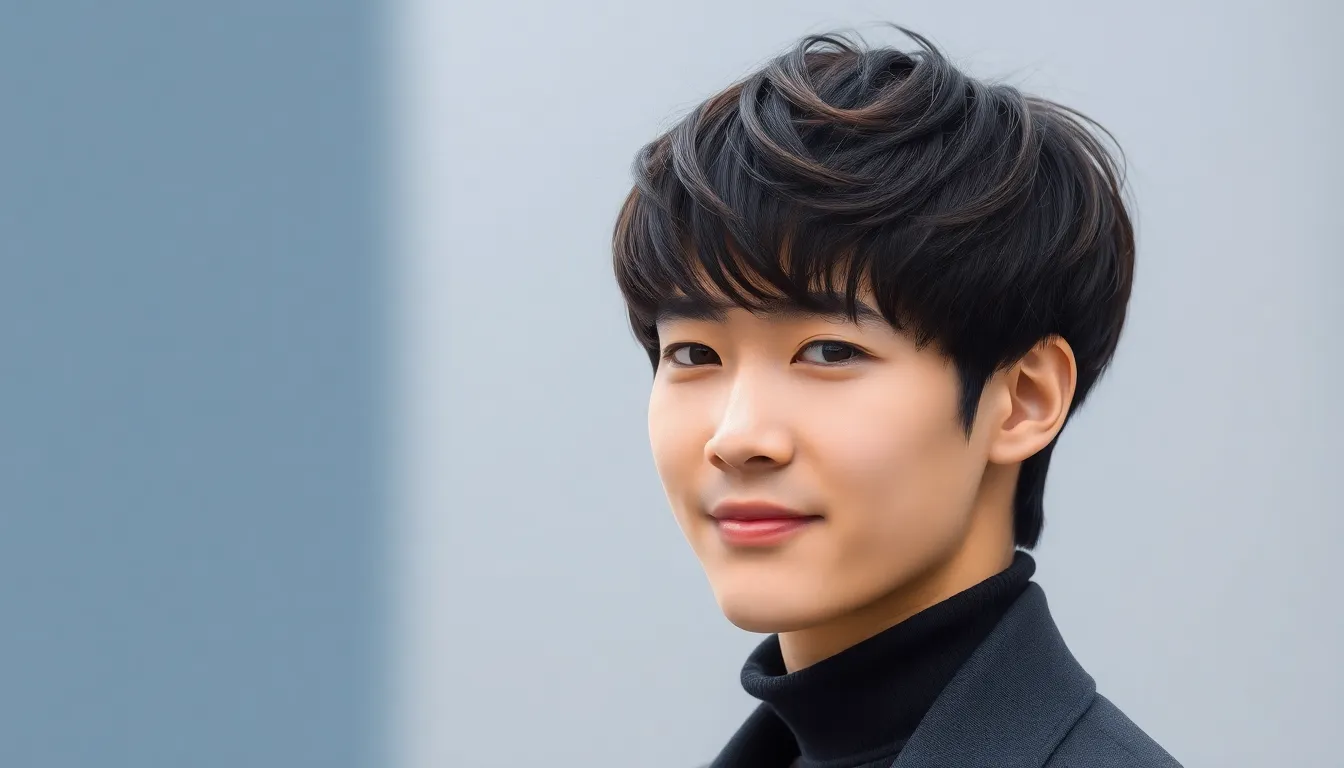
The Korean bowl cut transforms the traditional mushroom style into a sophisticated contemporary hairstyle. Modern stylists have refined this classic look to create cleaner lines and more versatile styling options.
Updated Features of the Contemporary Bowl Cut
Textured edges replace the blunt perimeter cuts that defined traditional bowl cuts. Korean stylists create subtle layers around the hairline to soften harsh lines and add natural movement. These textured finishing touches eliminate the helmet-like appearance while maintaining the bowl’s distinctive silhouette.
Strategic layering throughout the crown adds volume and dimension to what was once a flat hairstyle. Contemporary bowl cuts feature graduated lengths that range from 2-3 inches at the nape to 4-5 inches at the front. This layered approach creates better hair flow and prevents the style from looking too rigid or artificial.
Customized fringe lengths adapt to individual face shapes rather than following a one-size-fits-all approach. Modern Korean bowl cuts position the fringe anywhere from the eyebrows to mid-forehead based on facial proportions. Stylists adjust the fringe’s curve and density to complement each client’s features while preserving the cut’s signature rounded shape.
Refined side tapering creates smoother transitions between the bowl and the hairline. Instead of abrupt cutoffs, contemporary versions feature subtle fades that blend seamlessly into the neck and temple areas. This technical refinement makes the style more wearable for professional settings while maintaining its distinctive character.
Celebrity Inspirations and Variations
BTS member V popularized the asymmetrical bowl cut that features an off-center part and uneven fringe lengths. His version demonstrates how traditional bowl cuts can incorporate modern elements like subtle highlights and piece-y texture. This variation works particularly well for men with thick, straight hair who want to maintain some edginess.
Park Seo-joon showcases the professional bowl cut that’s perfect for office environments. His interpretation keeps the classic rounded shape while adding sophisticated touches like side-swept elements and refined edges. The styling appears polished without losing the youthful energy that makes Korean bowl cuts appealing.
Nam Joo-hyuk demonstrates the tousled bowl cut that combines the traditional silhouette with messy, lived-in texture. This casual approach uses styling products to create separation and movement within the bowl shape. The result maintains the cut’s recognition factor while appearing more relaxed and approachable.
Lee Min-ho represents the longer bowl cut variation that extends past the traditional eyebrow length. His version creates a more dramatic curtain effect while preserving the bowl’s curved perimeter. This extended approach works well for men who want the style’s benefits without committing to shorter lengths.
Textured Crop: Adding Volume and Movement
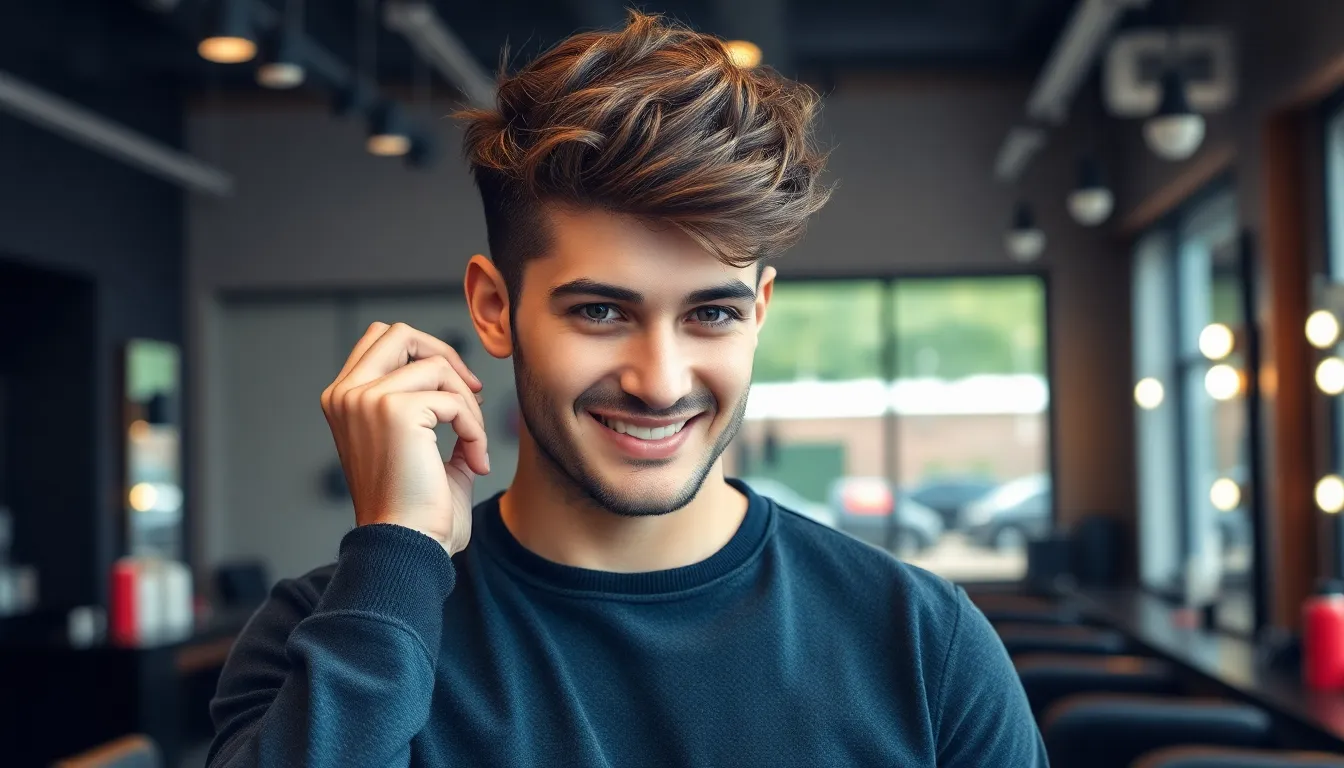
The textured crop represents a contemporary evolution of Korean men’s hairstyling that emphasizes natural movement and dimensional volume. This versatile cut builds upon the foundational principles we’ve explored while introducing sophisticated layering techniques.
Creating Natural Texture in Korean Hair
Choppy layers form the foundation of the textured crop by creating strategic length variations throughout the hair. We achieve this dimensional effect by cutting sections at different angles, typically ranging from 15 to 45 degrees, which allows individual strands to fall naturally without appearing too structured.
Point cutting techniques add irregular edges that enhance the natural texture Korean stylists are known for creating. This method involves cutting into the hair at various points rather than creating blunt lines, resulting in softer transitions and increased movement.
Thinning shears reduce bulk while maintaining length, particularly important for men with thicker hair textures. We recommend using these tools on approximately 30% of the hair’s density, focusing on mid lengths and ends to preserve volume at the roots.
Sea salt spray application enhances the crop’s natural texture when applied to damp hair before styling. This product creates grip and separation between strands, amplifying the cut’s inherent movement while providing a matte finish that complements the Korean aesthetic.
Scrunching motions during the drying process encourage the hair’s natural wave pattern and prevent over smoothing. We suggest using this technique with a diffuser attachment on medium heat settings to preserve the texture while reducing frizz.
Suitable Hair Types and Lengths
Fine to medium hair textures respond exceptionally well to the textured crop because the layering techniques add visual weight and body. Men with naturally straight hair benefit from the strategic cutting angles that create the illusion of fuller, more ever-changing hair.
Wavy hair patterns showcase the textured crop’s versatility by embracing natural movement while maintaining a polished appearance. The cut works particularly well with loose waves that fall in the 2A to 2B curl pattern range.
Hair lengths between 2 to 4 inches on top provide optimal results for achieving the signature textured crop look. This length range allows sufficient hair to create layers while maintaining the clean silhouette characteristic of Korean men’s hairstyles.
Shorter side lengths of 1 to 1.5 inches create the necessary contrast that makes the textured top appear more voluminous. The graduation between the sides and top should be gradual to maintain the style’s sophisticated appearance.
Thick hair densities require additional thinning and texturizing to prevent the cut from appearing too heavy or bulky. We recommend removing approximately 40% of the hair’s natural density while preserving the overall shape and structure.
Side Part Korean Style: Professional Yet Trendy
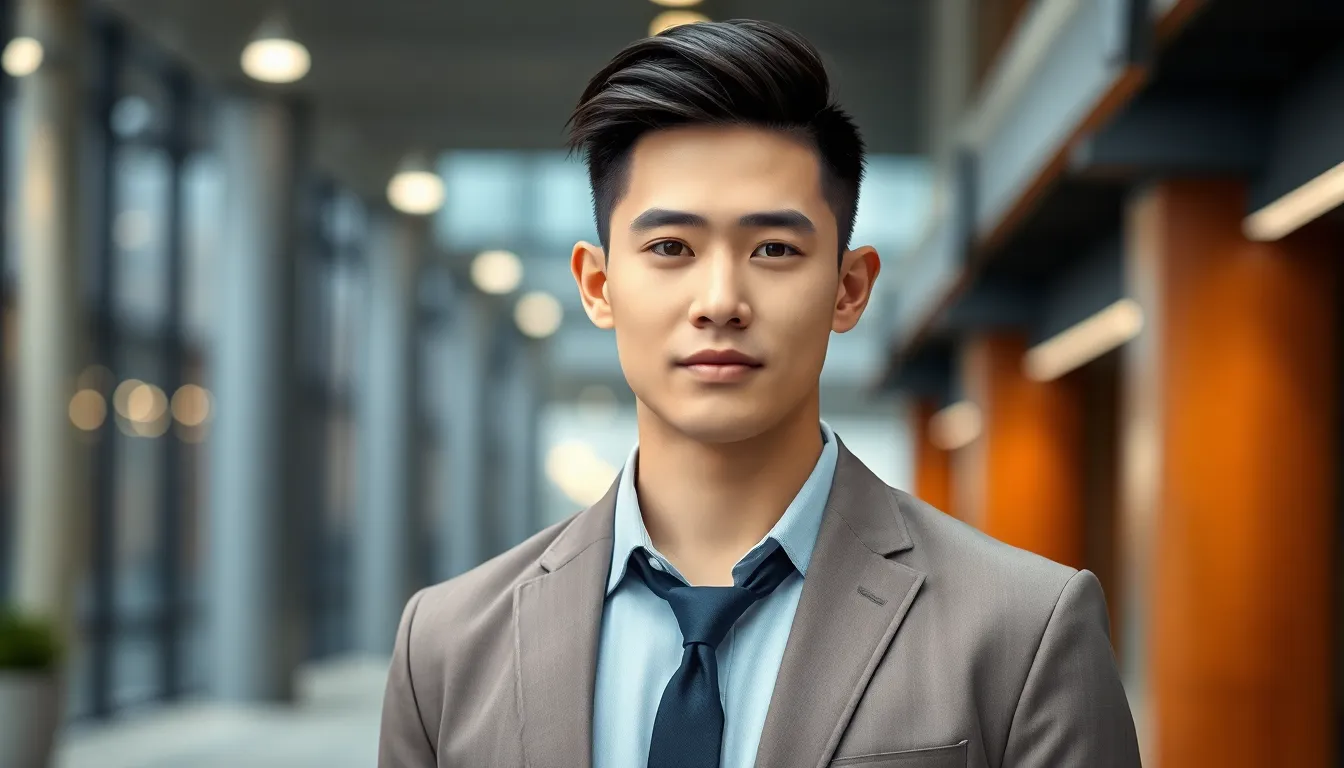
Side part Korean haircuts bridge the gap between workplace formality and contemporary style trends. We’ve seen this versatile cut dominate Korean men’s fashion for its ability to adapt from boardroom meetings to weekend casual wear.
Achieving the Perfect Side Part
Creating the ideal Korean side part begins with determining your natural hair growth pattern and face shape proportions. We recommend starting with damp hair and using a fine-tooth comb to establish a clean, defined part line approximately 1-2 inches from your center crown.
Hair preparation forms the foundation of this polished look. Apply a lightweight mousse or volumizing spray to towel-dried hair, focusing on the roots for natural lift. The key lies in creating height at the crown while maintaining sleek sides that gradually taper from 2-3 inches at the temples to shorter lengths near the ears.
Styling technique requires precision and the right tools. Use a round brush with medium tension while blow-drying, directing hair away from the part line to create volume. Korean stylists emphasize the importance of the 70-30 ratio, where the heavier side contains roughly 70% of your hair volume while the lighter side showcases 30%.
Product selection makes the difference between amateur and professional results. We suggest using a medium-hold pomade or styling cream that provides structure without appearing greasy. Apply the product evenly through mid-lengths to ends, avoiding the root area to maintain natural volume.
Formal and Casual Styling Options
Professional styling transforms the Korean side part into boardroom-ready sophistication. Sleek back the longer section using a fine-tooth comb and strong-hold gel, creating a polished finish that photographs well under office lighting. The shorter side should lay flat against the scalp with minimal texture or movement.
Weekend casual variations offer more relaxed interpretations of the classic cut. Tousle the longer section slightly with your fingers after applying texturizing paste, allowing for natural movement and a more approachable appearance. This styling works particularly well for social gatherings and informal meetings.
Special occasion adaptations elevate the look for weddings, dates, or formal events. Create additional height by backcombing the crown section before smoothing the surface with a bristle brush. Finish with a light misting of strong-hold hairspray to maintain the shape throughout long events.
Maintenance requirements for side part Korean cuts involve trimming every 4-5 weeks to preserve the clean lines. Regular washing every 2-3 days prevents product buildup while maintaining healthy scalp conditions that support optimal styling results.
Korean Mullet: The Edgy Modern Choice
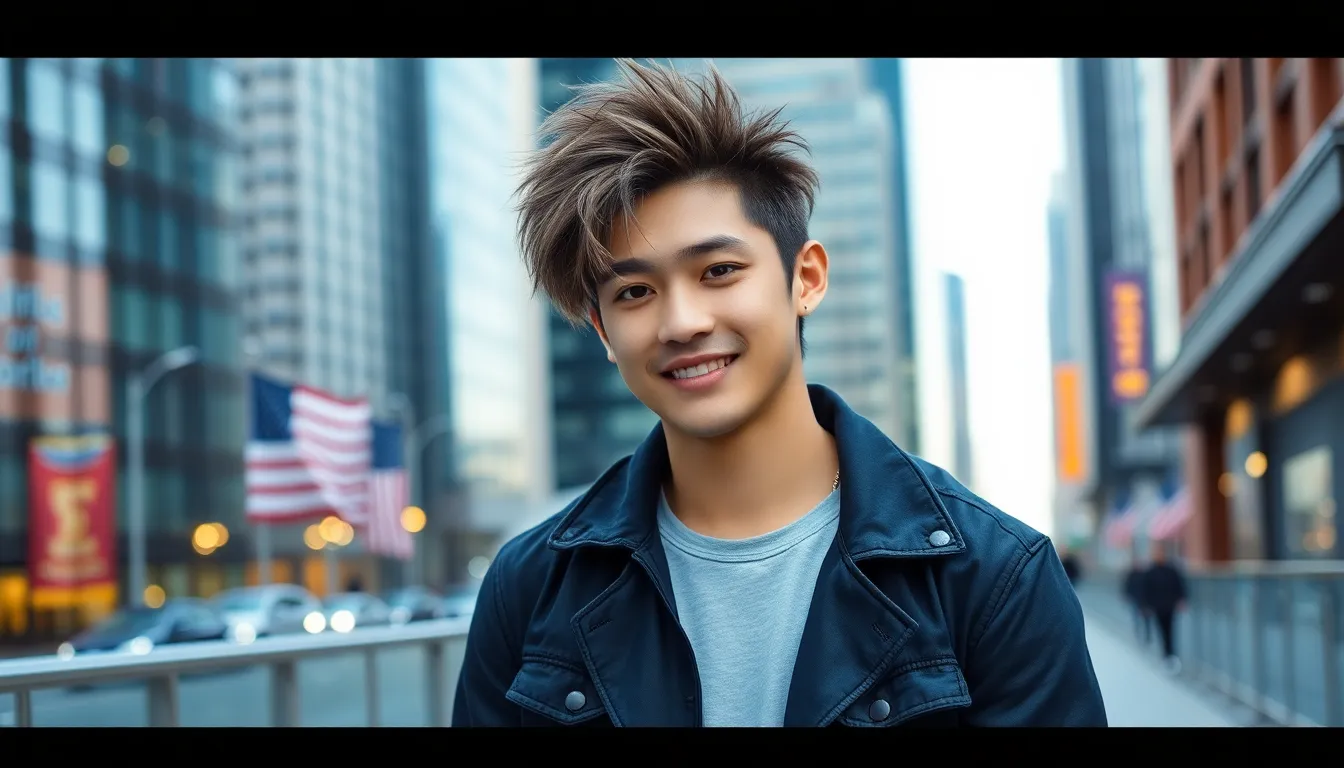
Korean mullets represent a bold departure from traditional men’s hairstyles, blending rebellious attitude with sophisticated Korean styling techniques. This contemporary interpretation transforms the classic mullet into a refined statement piece that maintains edge while embracing modern aesthetics.
How Korean Mullets Differ from Western Styles
Korean mullets prioritize subtlety over dramatic contrast, creating a more refined silhouette than their Western counterparts. Length variations between front and back sections typically measure 2-3 inches rather than the 4-6 inch differences seen in traditional mullets. This measured approach produces a sophisticated gradient that works well in professional settings.
Texture techniques set Korean mullets apart through strategic layering and thinning methods. Stylists use point cutting to create softer edges, while texturizing shears add movement without bulk. These methods prevent the harsh lines commonly associated with Western mullet styles.
Side styling incorporates tapered cuts that blend seamlessly into the longer back sections. Korean mullets feature sides trimmed to 1-2 inches with gradual transitions, creating cleaner profiles than abrupt Western style contrasts. This technique maintains the mullet’s distinctive shape while ensuring versatility.
Color integration often includes subtle highlights or lowlights that enhance the cut’s dimensional qualities. Korean stylists frequently use ash tones or caramel accents to create depth, moving away from the single tone approach typical in Western interpretations.
Styling and Maintenance Tips
Daily styling requires lightweight products that enhance natural texture without weighing hair down. We recommend using texturizing paste on damp hair, focusing on the back sections to create separation and movement. Apply a small amount of sea salt spray to add grip and hold throughout the day.
Heat styling techniques help achieve the signature Korean mullet shape using a blow dryer with diffuser attachment. Direct airflow upward on back sections while finger combing to create lift and volume. Use a round brush on front sections to maintain smoothness and control.
Maintenance scheduling demands professional trims every 4-5 weeks to preserve the cut’s balanced proportions. Focus appointments on refining the gradient between lengths and cleaning up side tapering. Regular maintenance prevents the mullet from becoming unruly or losing its sophisticated edge.
Product recommendations include lightweight pomades for formal occasions and dry shampoo for texture enhancement on non wash days. Avoid heavy gels or waxes that can create stiffness, instead opting for flexible hold products that maintain natural movement.
| Styling Element | Recommended Frequency | Product Type |
|---|---|---|
| Daily texturizing | Once per day | Texturizing paste |
| Heat styling | 2-3 times per week | Heat protectant spray |
| Professional trims | Every 4-5 weeks | N/A |
| Deep conditioning | Weekly | Moisturizing mask |
Slicked Back Korean Hair: Sophisticated and Clean
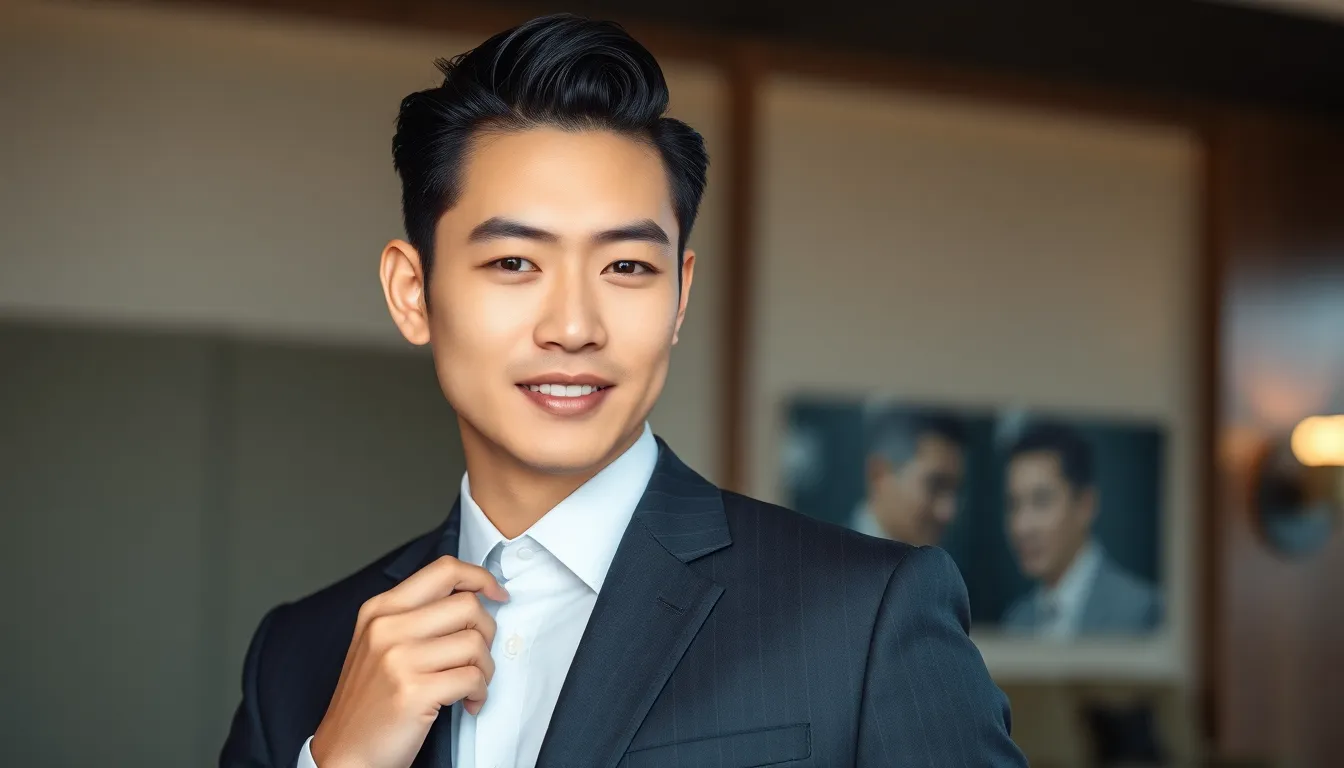
The slicked back Korean hairstyle represents the pinnacle of refined masculinity, combining sleek elegance with contemporary appeal. We’ve seen this polished look gain tremendous popularity through Korean business dramas and red carpet appearances, where stars showcase its versatility and timeless sophistication.
Products Needed for the Slicked Back Look
Strong hold pomade forms the foundation of any successful slicked back Korean style, providing the grip needed to keep hair in place for 8-12 hours. Water based pomades work exceptionally well because they offer excellent hold without leaving residue or creating buildup on your scalp.
Hair gel with medium to high shine creates that signature glossy finish we associate with Korean slicked back styles. Look for alcohol free formulas that won’t dry out your hair or cause flaking throughout the day.
Fine tooth comb becomes your most important styling tool for achieving those perfectly straight lines that define Korean slicked back hair. Metal combs distribute product more evenly than plastic alternatives, creating smoother results.
Heat protectant spray shields your hair from damage when using blow dryers or straightening tools to prep your style. Apply this before any heat styling to maintain healthy hair texture over time.
Lightweight hair oil adds extra shine and smoothness to your finished look while preventing frizz throughout the day. Argan oil or jojoba oil work particularly well for this purpose without weighing hair down.
Occasions Perfect for This Style
Business meetings and corporate events showcase the slicked back Korean style’s professional appeal, projecting confidence and attention to detail. We recommend this look for presentations, client meetings, or any situation where you need to make a strong first impression.
Formal dinners and black tie events call for the sophisticated elegance that slicked back Korean hair provides. The polished appearance complements suits and formal wear perfectly, creating a cohesive upscale look.
Wedding ceremonies and special celebrations benefit from this style’s photogenic qualities and all day staying power. Your slicked back hair will look just as sharp in evening photos as it did during morning preparations.
Date nights and romantic occasions allow you to display refined taste while maintaining approachable charm. The clean lines and glossy finish create an attractive, well groomed appearance that shows you care about your presentation.
Professional photoshoots and interviews require hairstyles that photograph well under various lighting conditions, making slicked back Korean hair an ideal choice. The sleek surface reflects light evenly, creating flattering results in both indoor and outdoor settings.
Korean Perm Styles: Adding Curl and Texture
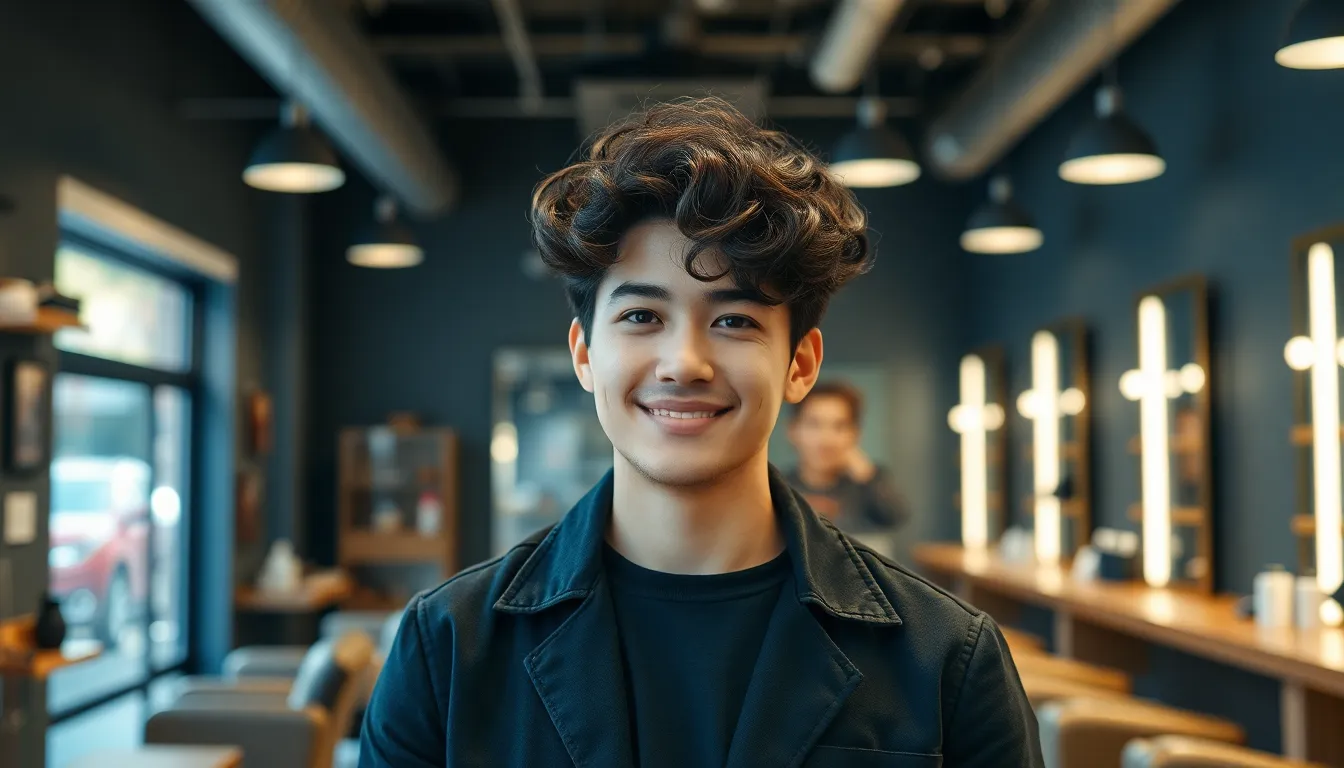
Permed hairstyles have revolutionized Korean men’s grooming, offering ever-changing alternatives to straight cuts while maintaining the signature Korean aesthetic. These treatments create natural looking waves and curls that complement various face shapes and hair textures.
Different Types of Korean Perms for Men
Digital Perms create loose, natural waves using heated rods that produce longer lasting curls with minimal damage. This technique works best on hair lengths between 4 to 6 inches, delivering soft spirals that maintain their shape for 6 to 8 months. Korean stylists prefer digital perms for their ability to create romantic, flowing textures that enhance the comma hair or textured crop styles.
Cold Wave Perms use chemical processing without heat to achieve tighter, more defined curls that suit shorter hair lengths of 2 to 4 inches. We recommend this method for men seeking voluminous texture in their two block cuts or bowl styles. Results typically last 4 to 6 months with proper maintenance and regular touch ups.
Root Perms target only the hair’s base to create lift and volume without affecting the mid lengths and ends. This selective approach works exceptionally well for fine hair, adding 30% to 40% more body at the crown area. Korean men often combine root perms with side part styles to achieve professional looks with enhanced dimension.
Spiral Perms produce defined corkscrew curls using vertical rod placement techniques that create consistent curl patterns from root to tip. Hair lengths of 5 to 7 inches showcase spiral perms most effectively, though Korean adaptations tend toward looser spirals for subtler results. These perms last 5 to 7 months depending on hair porosity and chemical processing history.
Body Wave Perms deliver gentle S shaped curves that mimic natural hair movement while adding subtle texture and bounce. We find body waves particularly effective for Korean mullet styles, where soft waves in the back sections create contemporary flow. Processing time ranges from 45 to 90 minutes, with results lasting 4 to 5 months.
Care Instructions for Permed Hair
Washing Frequency should be reduced to every 2 to 3 days to preserve curl definition and prevent excessive dryness that weakens perm structure. Korean hair care routines emphasize gentle sulfate free shampoos that clean without stripping natural oils. We recommend lukewarm water temperatures to maintain curl elasticity and prevent frizz formation.
Product Selection requires moisture rich formulas that enhance curl definition without weighing down the hair’s natural movement. Leave in conditioners with hydrating ingredients like argan oil or shea butter work best for permed Korean styles. Avoid alcohol based products that can cause dryness and compromise curl integrity over time.
Drying Techniques involve air drying or using diffuser attachments on low heat settings to maintain curl patterns without creating frizz. Scrunching motions while drying help define individual curls and add volume to permed styles. We suggest avoiding regular towels in favor of microfiber cloths that reduce friction and breakage.
Styling Methods focus on improving natural curl patterns rather than fighting against them with excessive heat or manipulation. Curl improving creams applied to damp hair provide hold and definition throughout the day. Avoid brushing or combing dry permed hair, which can disrupt curl formation and create unwanted volume.
Professional Maintenance requires salon visits every 6 to 8 weeks for trim ups that remove damaged ends and maintain the perm’s shape integrity. Korean stylists often recommend deep conditioning treatments every 4 weeks to replenish moisture lost during the perming process. Regular protein treatments can help strengthen chemically processed hair and extend perm longevity.
Korean Undercut Variations: Clean and Sharp
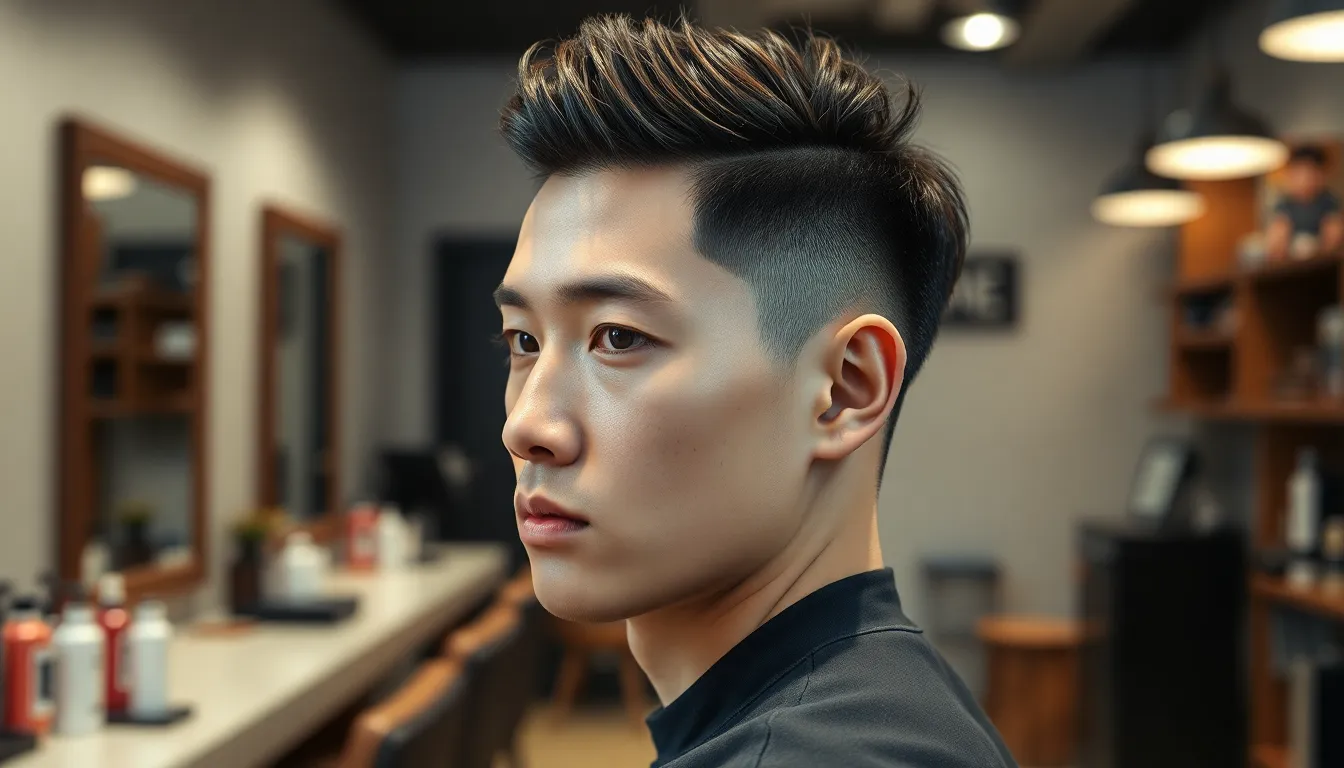
Korean undercuts have revolutionized men’s grooming with their precision and sophisticated approach to contrast styling. We’ve seen these sharp variations become essential elements in modern Korean barbershops.
Popular Undercut Patterns in Korea
Disconnected undercuts feature dramatic length differences between the top and sides, creating striking visual contrast. Korean barbers typically maintain 4-5 inches on top while cutting sides to skin level or grade 1. This pattern works exceptionally well with textured styling on top, allowing for versatile daily looks.
Gradual fade undercuts blend seamlessly from longer top sections to shorter sides using multiple clipper guards. We recommend starting with a grade 3 at the temples and fading down to skin level at the neckline. The transition zone spans approximately 1-2 inches, creating smooth gradations that suit professional environments.
Temple fade variations focus specifically on the side areas above the ears, leaving more length at the back and crown. Korean stylists often combine these with longer fringe sections, creating asymmetrical silhouettes that appear modern yet refined. The temple area typically measures 0.5-1 inch shorter than surrounding sections.
Nape undercuts target the lower back section while maintaining fuller sides and top portions. This subtle approach appeals to conservative dress codes while still providing contemporary edge. The undercut typically extends 2-3 inches up from the hairline, creating a hidden detail that’s revealed when hair is styled upward.
Combining Undercuts with Other Styles
Two block undercuts merge Korea’s most popular cut with precise undercutting techniques for enhanced definition. We position the undercut line slightly higher than traditional two blocks, typically 1-2 inches above the ear level. This combination creates sharper contrasts while maintaining the two block’s characteristic volume on top.
Comma hair undercuts pair the romantic curved fringe with clean side cutting for balanced proportions. The undercut helps manage bulk around the ears while the comma curve remains the focal point. Korean stylists recommend keeping the undercut subtle, using grade 2-3 clippers to avoid overwhelming the soft comma shape.
Textured crop undercuts enhance the choppy layered look with crisp side definition. This pairing works particularly well for thick hair types, as the undercut removes weight while the textured top maintains movement. We suggest using point cutting techniques on the crown while keeping undercut lines sharp and precise.
Korean mullet undercuts modernize the business-in-front party-in-back concept with contemporary precision. The undercut typically targets the side sections only, allowing the back length to flow naturally. This creates a sophisticated interpretation that’s workplace appropriate while maintaining the mullet’s distinctive silhouette.
Slicked back undercuts combine formal styling with edgy contrast for versatile professional looks. The undercut provides clean lines that enhance the slicked appearance, while the longer top section offers sufficient length for proper backward styling. Korean barbers often create subtle disconnection points that become visible when hair is styled away from the face.
Choosing the Right Korean Haircut for Your Face Shape
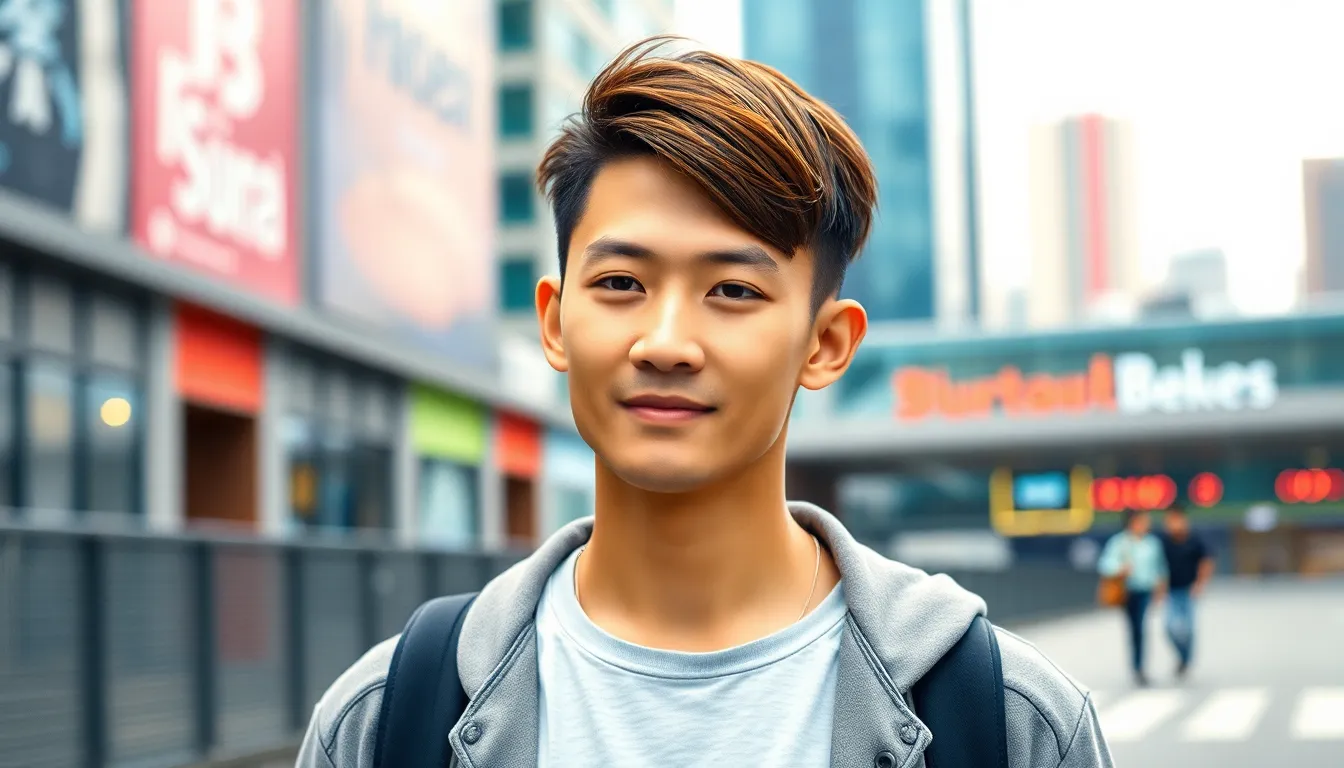
Finding the perfect Korean haircut depends on understanding how different styles complement your facial structure. We’ll guide you through the best Korean men’s hairstyles for each face shape to help you achieve that coveted K-style look.
Round Face Recommendations
Angular cuts work best for round faces by creating definition and length that balances softer facial curves. The two block cut stands out as our top recommendation because its sharp contrasts and clean lines add structure to rounder features.
Textured crops deliver excellent results for men with round faces who prefer a more casual approach. The choppy layers and dimensional volume create vertical lines that elongate the face while maintaining that effortless Korean aesthetic.
Side part Korean hairstyles offer professional versatility by drawing attention upward and creating asymmetrical lines. Position the part slightly off center and add volume at the crown to achieve maximum face lengthening effects.
Korean undercut variations enhance facial definition through strategic contrast styling. Opt for disconnected undercuts or temple fade variations that emphasize the upper portions of your hairstyle while keeping sides streamlined.
Square Face Styling Tips
Softening techniques transform angular jawlines into more balanced proportions using Korean styling methods. The comma hair excels for square faces because its gentle curved fringe creates romantic softness that counteracts sharp facial angles.
Korean perms add crucial movement to break up the geometric lines commonly found in square face shapes. Digital perms or body wave styles introduce flowing curves that complement rather than compete with strong jawlines.
Textured styling products enhance natural flow in Korean cuts designed for square faces. Use sea salt spray and lightweight mousses to encourage movement while avoiding products that create rigid, structured looks.
Layered Korean bowl cuts provide modern answers through graduated lengths that soften harsh edges. Request customized fringe lengths that graze the forehead gently rather than creating blunt horizontal lines across your face.
Oval Face Optimal Choices
Oval faces accommodate virtually any Korean haircut style due to their naturally balanced proportions and versatile bone structure. We recommend experimenting with bolder options like Korean mullets or dramatic undercut patterns.
Korean slicked back styles showcase classic elegance on oval face shapes where refined masculinity takes center stage. The sleek lines emphasize your natural facial balance while maintaining sophisticated appeal.
Experimental variations work exceptionally well for oval faced men seeking unique Korean aesthetics. Try combination styles that merge two block cuts with textured crops or incorporate undercut elements into comma hair designs.
Volume focused cuts maximize styling potential since oval faces don’t require exact corrective techniques. Root perms or crown focused texturing can add dramatic flair without disrupting your face’s natural harmony.
Conclusion
Korean men’s hairstyles have fundamentally transformed modern grooming by offering sophisticated options that work across different lifestyles and occasions. These cuts demonstrate how thoughtful styling can create looks that are both effortlessly cool and professionally polished.
The beauty of Korean haircuts lies in their adaptability – whether you’re drawn to the structured precision of a two block cut or the romantic softness of comma hair, there’s a style that’ll complement your features and personality.
We’ve seen how these trends continue to evolve while maintaining their signature attention to detail and clean lines. With the right cut and proper maintenance, you can achieve that coveted Korean aesthetic that’s captured attention worldwide.
Ready to make the switch? Book a consultation with a skilled barber who understands Korean styling techniques and start your journey toward effortlessly stylish hair.
Frequently Asked Questions
What is the most popular Korean men’s hairstyle?
The two block cut is currently the most popular Korean men’s hairstyle. It features a clean, structured appearance with longer hair on top (3-4 inches) and shorter sides (1-2 inches or less). This versatile cut creates striking contrast through sharp transitions and works well for both formal and casual occasions.
How do I style Korean comma hair?
To style comma hair, start with damp hair and create a deep side part. Use a round brush and blow dryer to curve the fringe forward, forming a comma shape. Apply lightweight styling products and finish with a gentle sweep across the forehead for that soft, romantic Korean drama look.
What face shapes suit Korean two block cuts?
The two block cut works well for square, oval, round, and heart-shaped faces. Its versatile nature and clean lines help balance facial proportions. The structured top and shorter sides create definition that complements various face shapes, making it one of the most universally flattering Korean hairstyles.
How often should I trim my Korean haircut?
Korean haircuts require maintenance every 4-5 weeks to keep their sharp, clean lines. Regular trims are essential for maintaining the precise contrast between lengths, especially for styles like the two block cut, comma hair, and Korean bowl cut that rely on specific proportions.
What products work best for Korean hairstyles?
Essential products include texturizing paste for definition, sea salt spray for natural texture, heat protectant spray for styling, and lightweight hair oil for shine. For slicked back styles, use strong hold pomade or gel. Choose products that enhance texture without weighing hair down.
Can Korean perms work on all hair types?
Korean perms work best on fine to medium hair textures. Digital perms suit straight hair seeking loose waves, while cold wave perms create defined curls. Root perms add volume to thin hair. Consult a professional to determine which perm type suits your hair texture and desired outcome.
How do I choose the right Korean haircut for my face shape?
Round faces benefit from angular cuts like two block cuts that add definition. Square faces look great with softer styles like comma hair or Korean perms. Oval faces can experiment with most Korean styles, including bold mullets and textured crops, due to their balanced proportions.
What makes Korean undercuts different from regular undercuts?
Korean undercuts emphasize precision and sophisticated contrast. They feature disconnected cuts, gradual fades, and temple variations that create cleaner lines. Korean undercuts often incorporate subtle patterns and are designed to complement other K-style elements like textured tops or styled fringes for a cohesive look.





